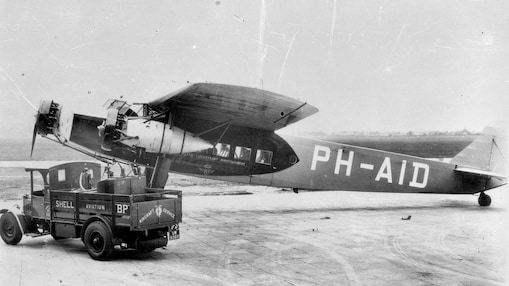The birth of efficient refuelling

In the 1920s, aircraft with larger fuel tanks were developed to enable longer journeys without the need for refuelling stops. This required a major rethink in fuelling procedures to cut the times needed to fill up the tanks and reduce time spent on the ground.
Commercial aircraft refuelling took a major step forward in 1921 when Shell Aviation built a new system using a 3,000 gallon, underground tank with pumps at London’s main airport in Croydon, one of the largest airports in the world at that time. Up until then, aircraft had been refuelled by hand, with tins of aviation spirit poured into a single lorry tank and then hand-pumped into the aircraft.
The new Croydon installation was based on a system developed by Shell during the First World War for the Royal Flying Corps. The system saw several underground pits placed at strategic points around the airfield to store the fuel and electric pumps employed to speedily fuel aircraft. Similar systems were built at other busy airports such as Berlin Tempelhof, Amsterdam Schiphol, and Paris Le Bourget.
This innovation was the precursor of the hydrant fuelling system that Shell would develop on a large scale from the start of the 1950s when the advent of the jet engine and introduction of larger airliners drove the requirement for faster refuelling. Shell also played a role in the development of larger refueller trucks over the years to bring faster and more efficient refuelling to airports where hydrant systems were not installed.
The installation of the underground system at Croydon Airport proved an important step on the journey to the efficient refuelling and fast turnaround times that support modern aviation. Today, Shell continues to work with airlines to increase the efficiency of refuelling with the introduction of digital technology to speed up turnaround times and reduce time and cost.
Sources:
SHA, Shell Aviation Magazine, 1972, p. 206.
SHA, Shell Aviation Magazine, 1932, p. 420-424.
H. Scanlan, Winged Shell. Oil Company Aviators 1927-1987, p. 12-13.
Shell Aviation News, 1954, p. 31.
Shell Aviation News, 1956, p. 174-177.
Shell Aviation News, 1957, p. 300.
Shell historical archives.

Decarbonising Aviation: Cleared for Take-off
Our new report, produced with Deloitte, reflects views from right across the aviation industry on the obstacles the sector faces and provides a clear pathway for the sector to accelerate progress towards net-zero emissions.

Work with us today for a low carbon future
Shell has supported the pioneers of aviation for over 100 years. Share your challenge and let’s work together today for a sustainable tomorrow.




